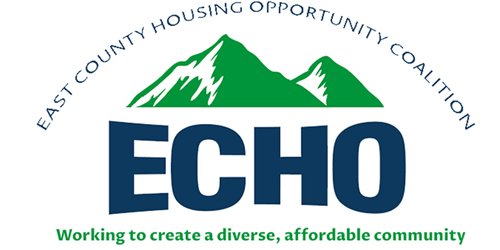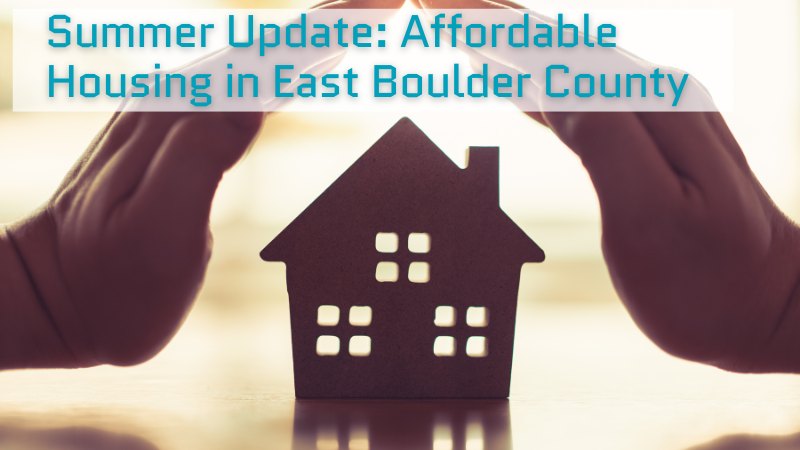Summer Update: Affordable Housing in East Boulder County
Louisville Housing Study — Seeking Public Input
The City of Louisville is seeking community opinions on housing. The city has hired a consulting team that will be presenting housing options to the city as part of a housing study. You can share your views at an open house at City Hall on June 21 from 6:00–8:00pm. The session will open with a short presentation about current data and the housing trends that Louisville is facing, followed by Q&A and small group activities. We encourage residents who want to see a more diverse and affordable Louisville to attend.
A presentation and discussion with the Louisville Planning Commission will take place on June 22.
Elections Are Coming, and We Want You!
Local governments in our area will have many council and town board seats up for election/re-election this November. ECHO is planning to conduct candidate questionnaires in the months ahead and to meet with the candidates to hear their views on affordable housing. We would love to have help from community members who want to get involved. Because ECHO is nonpartisan, we only ask questions and share information—we do not endorse candidates.
Helping ECHO connect with the candidates will take only a few hours of your time, and it will generate important information for voters to consider.
If you would like to be a part of ECHO’s non-partisan election activities in your community, email us at ECHOBoulderCounty@gmail.com.
Implementing Proposition 123
The Town of Erie has taken action to opt into the requirements for Proposition 123, and ECHO applauds their efforts. Proposition 123, which was passed by the voters in 2022, creates approximately $300 million in available revenue for affordable housing each year. To be eligible for funding, local governments must streamline their permit approval process and commit to increasing their affordable housing stock by 3% per year for three years. Erie staff will be submitting the paperwork to show that Erie is meeting the requirements and has a plan. Join ECHO in thanking the Erie Town Board for supporting these efforts.
The Lafayette City Council is planning a Proposition 123 conversation on July 24, and many other communities are planning a similar conversation.
If you would like to see your community opt in to Proposition 123 funding, NOW is the time to let them know. What a shame it would be if East Boulder County did not receive these funds to help build more affordable and diverse communities.
Here’s how to contact the elected officials in your community:
Lafayette – https://www.echocolorado.com/lafayette
Longmont – https://www.echocolorado.com/longmont
Louisville – https://www.echocolorado.com/louisville
Superior – https://www.echocolorado.com/superior
ECHO Website Refresh
Our website has been refreshed recently with lots of useful information about how to communicate with local elected officials and planning commissions and where to get information about upcoming housing projects. Check it out, and bookmark the ECHO website as a handy tool for how to get useful housing information as well as how to communicate with the right people at the right times.
Affordable, Attainable, and Workforce Housing – What Do Those Terms Mean?
Affordable housing —
Affordable housing is generally defined as housing that allows an occupant who makes 80% or less of the area median income (AMI) to pay no more than 30% of their gross income for housing costs, including utilities. Because it’s hard for a builder to recover their costs through rent or mortgages when they develop this type of housing, it typically does not get built without a subsidy of some kind. Projects often requires several different layers of subsidy, such as federal dollars, state dollars, and local dollars. In addition, rental housing financing often includes a form of funding called tax credit funding. Tax credits are awarded to developers of qualified projects. Developers then sell these credits to investors to raise capital (or equity) for their projects, which reduces the debt that the developer would otherwise have to borrow. Because the debt is lower, a tax credit property can in turn offer lower, more affordable rents. Tax credits are one of the most significant ways of financing affordable housing, and because they are only available for rental properties, they are one of the reasons you see fewer for-sale affordable projects.
Attainable housing —
Generally, attainable housing is intended for people who make too much money to qualify for traditional, subsidized “affordable” housing — meaning they make more than 80% of AMI — but who still struggle to find housing that eats up no more than 30% of their income. One of the biggest differences between “affordable” and “attainable” housing is that attainable housing could still cost the market rate, though in high-cost areas this is less likely. This contrasts with affordable housing, which needs to be subsidized or priced based on income so people who are considered low-income or very low-income can afford it.
Workforce housing —
Workforce housing is very similar to attainable housing. The term is often used to refer to housing for those who earn too much “to qualify for traditional affordable housing subsidies” but who still struggle to make rent or mortgage payments at market price. The U.S. Department of Housing and Urban Development (HUD) has programs for people making 80% of AMI or less; the Brookings Institution states that workforce housing is “most commonly intended for households with incomes between 80% and 120% of AMI.” It can also be used to target workers in specific industries, such as teachers, first responders, and rural resorts and tourism.
Locally, the City of Longmont has launched the Middle Tier program to incentivize developers to build housing for people earning at the 80% to 120% AMI levels. So far, only 10 units have been built, and the city will be reassessing the program’s effectiveness.
Thanks to the Fort Collins Coloradoan for providing these definitions! Source: “Affordable housing can be a complex topic. Here's what to know about it in Fort Collins.” Molly Bohannon, Fort Collins Coloradoan , March 3, 2013.
https://www.coloradoan.com/story/news/2023/03/13/fort-collins-affordable-housing-glossary-key-definitions-organizations/69985646007/Attainable Housing Project Proposed for Longmont Area
Attainable housing is one of Longmont’s goals, and a project now being discussed has the potential to add up to 426 units of attainable workforce housing.
On July 7, Boulder County Commissioners will vote on whether to approve the vacation of a conservation easement in order for new attainable housing to move forward. The site is currently just outside the Longmont city limits, but it could potentially be annexed into the city. When the easement was put in place, unlike with many easements, a process was created for it to be vacated for future development of the property. The draft agreement calls for the developer to give $2.3 million to the county to transfer the development rights to the land, which the county can then use to create open space or an easement elsewhere.
At a recent Boulder County Planning Commission meeting, the Planning Commission voted unanimously to vacate the easement; however, some residents of the area opposed the project. We often see residents oppose new housing development, especially when it will create housing for more modest income households.
The plan for Somerset Village will include energy conservation and denser, attainable housing near transportation corridors, with plenty of greenspace. It will also include an early childhood center, a community center, and a ride-sharing plaza in a walkable environment that includes some retail.
To learn more about the project, access the presentation that was given to the Planning Commission here: https://assets.bouldercounty.gov/wp-content/uploads/2023/03/kanemoto-estates-conservation-easement-termination-staff-report-20230315.pdf
ECHO encourages Boulder County residents who support this project to write to the Boulder County Commissioners to express your support or to testify at the hearing on July 7. Information on how to connect with the Commissioners is provided here: https://www.echocolorado.com/boulder-county.
ECHO Survey on Housing Issues of Interest to Longmont Residents
ECHO is conducting a survey to learn about the housing issues that Longmont residents are concerned about. If you live in Longmont, we want to hear from you on your housing priorities.
Please fill out the survey here:
https://docs.google.com/forms/d/1KfA8KSlAGUYjyn_7yTmxKFCKgKVqMufgWyvaRstb1Dc/edit
Thanks for reading!



